Cohen, Peter (1989),
Cocaine use in Amsterdam in non-deviant subcultures. In: Peter Cohen (1990),
Drugs as a social construct. Dissertation. Amsterdam, Universiteit
van Amsterdam. pp. 153-162.
© Copyright 1990 Peter Cohen.
All rights reserved.
12. Opinions, advice and cocaine policy
Peter Cohen
- 12.1 - Introduction
- 12.2 - Opinions about cocaine use
- 12.3 - Change in opinions after onset of own cocaine use
- 12.4 - Advice to novice users
- 12.5 - Preference for a drug policy relating to cocaine
Table of contents
12.1 Introduction
Most people know little or nothing about cocaine. At best members of the public pick up biased facts and attitudes from the media and significant others such as doctors. We wanted to know from our experienced cocaine users' opinions (and changes thereof) in relation to cocaine use. We asked them about changes in opinion in two stages: 1) before the onset of their own cocaine use, and 2) during their cocaine using career.
In this chapter we will also deal with rules of use. As part of our curiosity about cocaine users' rules about regulation of consumption, we introduced a few questions concerning advice to novice cocaine users. We assumed such questions would shed some light on the rules that experienced cocaine users consider important, independently of their own succes at having followed them.
Related to personal rules are societal laws. Accordingly we asked respondents about their attitudes to government regulation of cocaine use.
12.2 Opinions about cocaine use
Of all respondents, 68% recalled what they thought about cocaine before the onset of their own use. Of the remainder, 29% had forgotten, and 3% did not answer this question. Those respondents that remembered their former ideas had the opportunity to answer an open-ended question. Respondents with recall remembered having mainly negative opinions of cocaine's characteristics. The most mentioned positive aspect was cocaine's energizing action. Because this is also the most often mentioned positive effect by current cocaine users (see chapter 9), interference between current ideas and assumed older ideas on this point cannot be excluded. In as far as any ideas could be recalled about the type of persons using cocaine, these were mainly successful, rich or artistic people. There is also a category of respondents who mainly associated cocaine with junkies, deviant and non sympathetic persons. Sources of opinions one had before the onset of one's own cocaine use were mainly personal observations, friends and the media. Parents, teachers or drug information programs are rarely mentioned as source of opinion formation on cocaine.
Table 12.2.a Assumed characteristics of cocaine before onset of own cocaine use (N=160)
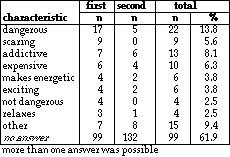
Table 12.2.b Assumed characteristics of cocaine users before onset of own cocaine use (N=160)
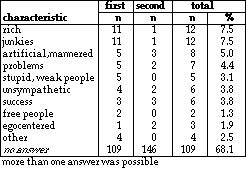
In table 12.2.a we present the number of times a certain characteristic is mentioned as a first and as a second item. In the last column the percentage of respondents (N=160) that remembered each cocaine characteristic is given.
Some of the 'old' opinions we found among present cocaine users were cross tabulated with their source. We selected those users who stated they had as opinion about cocaine 'dangerous and/or scaring' [dangerous] and the users that reported 'addictive' as old opinion about cocaine.
We have to treat these data with a great deal of caution, because they are reported by very few respondents. That is also the reason why it does not make much sense to test the significance of some sources being more responsible than other sources for the opinions that cocaine was believed to be 'dangerous' or 'addictive'.
Table 12.2.c Sources of opinions about cocaine, before onset of own use (N=160)
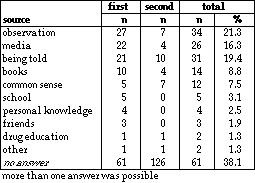
Table 12.2.d Source of different first opinions about cocaine, in % (N=160)

School and the media are the only sources that are more often mentioned by those whose original naive opinions about cocaine were that it was 'dangerous or scaring'. For the opinion 'addictive', books also play a important role.
12.3 Change in opinions after onset of own cocaine use
Of all respondents, 64% reported a change in their opinion of cocaine since they first used it. 23% did not change their opinion and 13% did not answer this question. Of those who did change their opinion 30% changed in a more positive direction, 20% in a more negative one.
We did not find any significant difference in changes of opinion between users that had stopped and users that were continuing cocaine use when interviewed.
Table 12.3.a Change in opinion about cocaine after onset of use
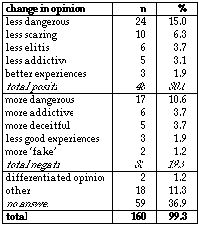
Table 12.3.b Direction of change of opinion for those whose initial opinion was either 'dangerous, scaring' vs 'other' and 'addictive' vs 'other'
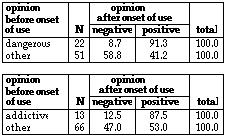
In Table 12.3.b we checked whether those who originally had negative ideas about cocaine had changed their minds in the opposite direction, or were merely more confirmed in their original ideas. The category 'negative' in this table consists of the opinions 'more dangerous', 'more addictive', 'more deceitful' and 'bad experiences'. The category 'positive' consists of 'less dangerous', 'less scaring', 'less addictive' and 'doesn't make you a junkie'.
Difference between opinions before and after onset of use is statistically significant at the 0.001 level (Kendall's tau = -0.55; standard error = 0.11). The significance of the change of mind of those who thought cocaine 'addictive', cannot be computed, due to the small number of respondents concerned.
Cocaine-using friends are the most important influence on opinion change, followed at some distance by the media and books (table 12.3.d).
Of course respondents' own subjective experience with cocaine was probably important in influencing changes in direction of opinion, in addition to the sources mentioned in table 12.3.c. We have no way, however, in which to compare relative importance of own experience with mentioned other sources.
Table 12.3.c Sources of changes in opinion
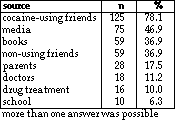
Table 12.3.d Influence of different sources on direction of change of opinion
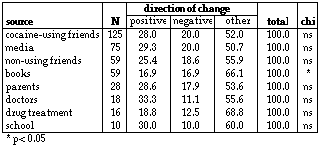
12.4 Advice to novice users
We asked our respondents what advice they would now give to novice users about: mode of ingestion, dose, circumstances fit to use cocaine, combination of cocaine with other drugs, buying cocaine, disadvantages of cocaine, and methods of countering these. Summarized, a general type of advice can be constructed from these data: when using cocaine, restrict yourself to snorting; use it when you feel well already together with nice company; and do not use much of it. Cocaine can be combined with other drugs, but with care if with alcohol or cannabis; buy your cocaine from trusted people, and preferably not in public places. This seems to reflect a rather calvinistic ideal recommending moderate drug use.
In the Tables 12.4.a through 12.4.f we present data on advice in a more detailed way.
Table 12.4.a Advice for novice users of cocaine relating to mode of ingestion (N=160)
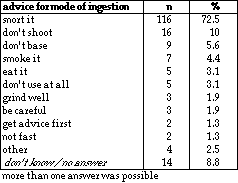
Table 12.4.b Advice for novice users of cocaine relating to quantity
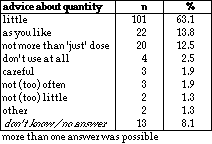
Table 12.4.c Advice for novice users of cocaine relating to circumstances of use
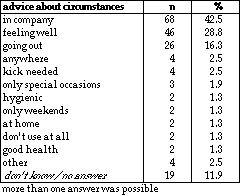
Table 12.4.d Advice for novice users of cocaine relating to combinations with other drugs
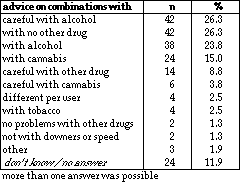
Table 12.4.e Advice for novice users of cocaine relating to buying cocaine
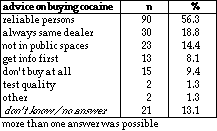
Table 12.4.f Advice for novice users of cocaine relating to countering ill effects[2]
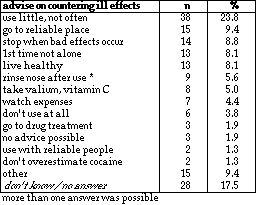
12.5 Preference for a drug policy relating to cocaine
We asked respondents to answer a question about the preferred national
cocaine policy that they would prefer. We gave them a choice between policies
similar to those already effective in the Netherlands for alcohol, for
cannabis and for heroin, and in that order of increasing repression.
Alcohol is freely available through a large distribution network, heavily
supported by advertising. Prices are low.
Cannabis is far less freely available in the larger cities, through an inconspicuous distribution network of youth clubs or small commercial outlets. A de facto social tolerance has taken place. Advertising is prohibited however. Prices for different qualities range between Ÿ 3 and Ÿ 10 per gram for marijuana and between Ÿ 8 and Ÿ15 per gram for hashish. Police confiscate quantities larger than 30 grams. Police attention to consumption or small scale dealing is low, although enforcement zeal relating to small scale dealing is variable.
Access to heroin is difficult but possible in the larger cities, where distribution operates in a black market system. Quantities over 1 gram are confiscated when found and prices are ca Ÿ 150 a gram. Police attention is high. Enforcement zeal is high in some areas which means that social risks to heroin users are high as well.
The present situation with respect to cocaine in Amsterdam is that police almost inevitably prosecute cases of large scale dealing of cocaine, and cocaine use by street junkies. The junkie (street) cocaine market is quite separate from the distribution systems that operated for the majority of the respondents in this sample. For the latter, cocaine of relatively high quality is distributed by a number of small scale dealers that operate in an inconspicuous and not very open network. Police attention to this part of the market is low. The present state of affairs in relation to suppression of cocaine use is somewhere between cannabis and heroin, somewhat nearer to the former.
Table 12.5.a Preferred cocaine policy
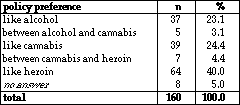
A majority of the cocaine users opt for a cocaine policy which is is either complete legalization (as with alcohol) or quasi legalization (as for cannabis). The most frequently mentioned arguments for this were: cocaine would then be removed from its criminal context; cocaine is just as (non) dangerous as cannabis or alcohol; and users themselves are responsible for their drug use, not the State. A sizable minority however was in favour of a cocaine policy like the one we have for heroin. The main arguments were the hazards of cocaine and its possibility of habit formation.
When we compare respondents who have stopped using cocaine with those still using cocaine, we see a statistically highly significant overrepresentation of ex-users opting for cocaine to be treated like heroin (61.9% vs 34.5%, chi2, p <0.001).
This may be explained by a tendency of ex-users to look for external support for behaviour change decisions. With ex-smokers we see the same tendency to be 'tougher' than smokers. Prohibition of smoking in public places is supported by 69.1% of Belgian ex-tobacco users versus 48.4% of current tobacco users (Joossens, 1981). For cannabis users Erickson found similar reactions (Erickson, 1989). She assumes there is a general principle operating here,to the effect that the nebulous 'others' are less likely to be controlled than 'I' myself. [1]
A recent study by Mugford and Cohen of 73 recreational coccaine users in Australia revealed that about 30% of the respondents "would have neither cocaine nor heroin legally available to the public. Many were of the opinion that while they themselves were able to control their use of these drugs they were not confident that other people would be so succesful in this regard" (Mugford and Cohen, 1989, p 47)
Table 12.5.b Motives behind preferred cocaine policy option (N=148)
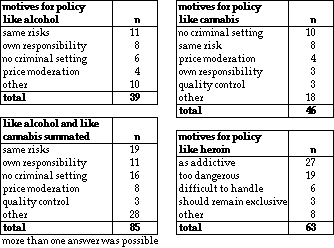
Another explanation could be that users know the 'dangers of cocaine' from their own experience and thus provide a genuine basis for cocaine policy. However, such an explanation does not take into account that most cocaine users in our sample have never been subject to a manifest reppressive policy or to social attitudes such as those manifest towards heroin users, neither by police nor in their close social surroundings. Such an explanation also does not recognize that a large majority of users have found some kind of regulated balance for their moderate use and that a substantial number have been able to lace their cocaine using career with periods of abstinence of one month or longer. And most important, the relatively large group of ex-cocaine users opting for a repressive cocaine policy have been able to stop using cocaine in spite of the absence of such a policy directed towards them. Apparently the present absence of a policy in which heroin and cocaine are treated the same has not resulted in absence of balanced cocaine use for this sample. This state of affairs allows the assumption that most cocaine users in our sample have been able to discipline their use or become abstinent without the help of strong external powers of repression. (In contrast, for junkie type heroin- or cocaine-users not included in our sample, the presence of strong prohibitive reppression directed towards them has not been able to prevent their deviant patterns of use.)
However, the fact that a third of the experienced cocaine users wanted a tougher policy for cocaine than is presently offered remains a very interesting datum. In follow-up research we will have to allow for the emergence of data that might explain this.
